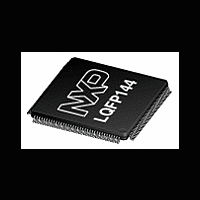LPC2926_27_29 NXP Semiconductors, LPC2926_27_29 Datasheet - Page 35

LPC2926_27_29
Manufacturer Part Number
LPC2926_27_29
Description
The LPC2926/2927/2929 combine an ARM968E-S CPU core with two integrated TCMblocks operating at frequencies of up to 125 MHz, Full-speed USB 2
Manufacturer
NXP Semiconductors
Datasheet
1.LPC2926_27_29.pdf
(95 pages)
- Current page: 35 of 95
- Download datasheet (2Mb)
NXP Semiconductors
LPC2926_27_29
Product data sheet
6.13.5.3 Clock description
6.13.6.1 Functional description
6.13.6.2 Pin description
6.13.6 General-purpose I/O
Table 18.
[1]
[2]
The SPI modules are clocked by two different clocks; CLK_SYS_PESS and CLK_SPIx
(x = 0, 1, 2), see
power management. The frequency of all clocks CLK_SPIx is identical as they are derived
from the same base clock BASE_CLK_SPI. The register interface towards the system bus
is clocked by CLK_SYS_PESS. The serial-clock rate divisor is clocked by CLK_SPIx.
The SPI clock frequency can be controlled by the CGU. In master mode the SPI clock
frequency (CLK_SPIx) must be set to at least twice the SPI serial clock rate on the
interface. In slave mode CLK_SPIx must be set to four times the SPI serial clock rate on
the interface.
The LPC2926/2927/2929 contains four general-purpose I/O ports located at different
peripheral base addresses. In the 144-pin package all four ports are available. All I/O pins
are bidirectional, and the direction can be programmed individually. The I/O pad behavior
depends on the configuration programmed in the port function-select registers.
The key features are:
The general-purpose I/O provides individual control over each bidirectional port pin. There
are two registers to control I/O direction and output level. The inputs are synchronized to
achieve stable read-levels.
To generate an open-drain output, set the bit in the output register to the desired value.
Use the direction register to control the signal. When set to output, the output driver
actively drives the value on the output: when set to input the signal floats and can be
pulled up internally or externally.
The five GPIO ports in the LPC2926/2927/2929 have the pins listed below. The GPIO pins
are combined with other functions on the port pins of the LPC2926/2927/2929.
shows the GPIO pins.
Symbol
SPIx SCK
SPIx SDI
SPIx SDO
•
•
•
•
Direction of SPIx SCS and SPIx SCK pins depends on master or slave mode. These pins are output in
master mode, input in slave mode.
In slave mode there is only one chip select input pin, SPIx SCS0. The other chip selects have no function in
slave mode.
General-purpose parallel inputs and outputs
Direction control of individual bits
Synchronized input sampling for stable input-data values
All I/O defaults to input at reset to avoid any possible bus conflicts
SPI pins
SCKx
SDIx
SDOx
Pin name
All information provided in this document is subject to legal disclaimers.
Section
…continued
Rev. 5 — 28 September 2010
6.7.2. Note that each SPI has its own CLK_SPIx branch clock for
IN
OUT
Direction
IN/OUT
ARM9 microcontroller with CAN, LIN, and USB
SPIx data input
SPIx data output
Description
SPIx clock
LPC2926/2927/2929
[1]
© NXP B.V. 2010. All rights reserved.
Table 19
35 of 95
Related parts for LPC2926_27_29
Image
Part Number
Description
Manufacturer
Datasheet
Request
R
Part Number:
Description:
Lpc2926/2927/2929 Arm9 Microcontroller With Can, Lin, And Usb
Manufacturer:
NXP Semiconductors
Datasheet:
Part Number:
Description:
NXP Semiconductors designed the LPC2420/2460 microcontroller around a 16-bit/32-bitARM7TDMI-S CPU core with real-time debug interfaces that include both JTAG andembedded trace
Manufacturer:
NXP Semiconductors
Datasheet:

Part Number:
Description:
NXP Semiconductors designed the LPC2458 microcontroller around a 16-bit/32-bitARM7TDMI-S CPU core with real-time debug interfaces that include both JTAG andembedded trace
Manufacturer:
NXP Semiconductors
Datasheet:
Part Number:
Description:
NXP Semiconductors designed the LPC2468 microcontroller around a 16-bit/32-bitARM7TDMI-S CPU core with real-time debug interfaces that include both JTAG andembedded trace
Manufacturer:
NXP Semiconductors
Datasheet:
Part Number:
Description:
NXP Semiconductors designed the LPC2470 microcontroller, powered by theARM7TDMI-S core, to be a highly integrated microcontroller for a wide range ofapplications that require advanced communications and high quality graphic displays
Manufacturer:
NXP Semiconductors
Datasheet:
Part Number:
Description:
NXP Semiconductors designed the LPC2478 microcontroller, powered by theARM7TDMI-S core, to be a highly integrated microcontroller for a wide range ofapplications that require advanced communications and high quality graphic displays
Manufacturer:
NXP Semiconductors
Datasheet:
Part Number:
Description:
The Philips Semiconductors XA (eXtended Architecture) family of 16-bit single-chip microcontrollers is powerful enough to easily handle the requirements of high performance embedded applications, yet inexpensive enough to compete in the market for hi
Manufacturer:
NXP Semiconductors
Datasheet:

Part Number:
Description:
The Philips Semiconductors XA (eXtended Architecture) family of 16-bit single-chip microcontrollers is powerful enough to easily handle the requirements of high performance embedded applications, yet inexpensive enough to compete in the market for hi
Manufacturer:
NXP Semiconductors
Datasheet:
Part Number:
Description:
The XA-S3 device is a member of Philips Semiconductors? XA(eXtended Architecture) family of high performance 16-bitsingle-chip microcontrollers
Manufacturer:
NXP Semiconductors
Datasheet:

Part Number:
Description:
The NXP BlueStreak LH75401/LH75411 family consists of two low-cost 16/32-bit System-on-Chip (SoC) devices
Manufacturer:
NXP Semiconductors
Datasheet:

Part Number:
Description:
The NXP LPC3130/3131 combine an 180 MHz ARM926EJ-S CPU core, high-speed USB2
Manufacturer:
NXP Semiconductors
Datasheet:

Part Number:
Description:
The NXP LPC3141 combine a 270 MHz ARM926EJ-S CPU core, High-speed USB 2
Manufacturer:
NXP Semiconductors

Part Number:
Description:
The NXP LPC3143 combine a 270 MHz ARM926EJ-S CPU core, High-speed USB 2
Manufacturer:
NXP Semiconductors

Part Number:
Description:
The NXP LPC3152 combines an 180 MHz ARM926EJ-S CPU core, High-speed USB 2
Manufacturer:
NXP Semiconductors

Part Number:
Description:
The NXP LPC3154 combines an 180 MHz ARM926EJ-S CPU core, High-speed USB 2
Manufacturer:
NXP Semiconductors










